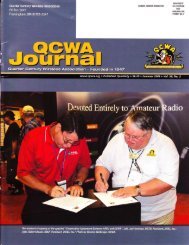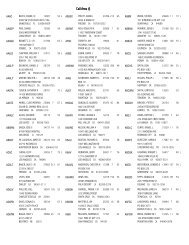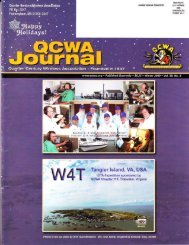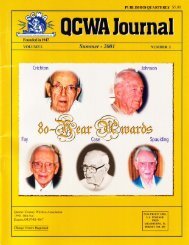Untitled - Quarter Century Wireless Association
Untitled - Quarter Century Wireless Association
Untitled - Quarter Century Wireless Association
You also want an ePaper? Increase the reach of your titles
YUMPU automatically turns print PDFs into web optimized ePapers that Google loves.
Silver BeIIes<br />
By: Carol King K5CPZ, hesident Chapter 63, P. O. Box 73, Oklahoma City, OK 73101<br />
Before discussing our featured YL, I<br />
would like to thank those of you who<br />
were so kind as to submit comments<br />
concerning this column. I value your<br />
input and I will do my best to<br />
implement your wishes with<br />
reference to the material on YLs.<br />
The original title of the<br />
column caused quite a "hum" of<br />
QRM! I was gratified to learn,<br />
though, that the column was at least<br />
read. Because I did not have<br />
rufficient time to work on a title for the column, I did not submit<br />
o title. Consequently, I regret that I cannot take credit for the<br />
column's original title which created such a variety of<br />
comments. I can, however, accept full responsibility for "Silver<br />
Belles." I/you would like to suggest another title, we would be<br />
delighted to hearfrom you.<br />
If you would prefer to dispense with a YL column of<br />
this kind for your lournal, please let us know. Omitting this<br />
column would neither alfect my salary nor cause hard feelings.<br />
Because this is vour Jowal, I am interested in hearing from<br />
you.<br />
Again, thank ysu for sharing your ideas, and please<br />
accept my best wishes to each ofyou. 33s to the ladies and 73s<br />
to the guys, de Carol King, KSCPZ.<br />
Esther Given, W6BDE, is our featured YL for this<br />
issue. When you have read about her accomplishments, her<br />
dedication, and her contributions to ham radio and humanity,<br />
you will have a great deal of appreciation for this very special<br />
YL.<br />
According to Esther, her childhood wasn't all that<br />
unusual. She was born in 19ll in New Jersey, but her family<br />
soon moved to the Denver area where she received her<br />
education. Because she had the experiences of an only child,<br />
sibling rivalry was never an issue for this YL.<br />
In W.W.[, when the Women's Army Auxiliary Corps<br />
(WAAC) was organized, Esther volunteered for the challenge of<br />
proving that a woman could handle a military assignment. In<br />
1942 she passed the aptitude test which enabled her to serve in<br />
the area ofradio personnel.<br />
Esther received her basic military training at Ft. Des<br />
Moines, Iowa, which was then the only basic training school for<br />
WAACS.<br />
In November 1942 she and her crew traveled by train<br />
from Iowa to Kansas City, Missouri for training in military<br />
radio communication. The group of two commanding offtcers<br />
and 100 WAACs paraded a mile in the rain from the railroad<br />
station to their new assignment as students in the Midland<br />
Radio School.<br />
The training period lasted for 13 weeks. Esther and her<br />
crew received intensive training in international Morse code,<br />
U.S. military operating procedures and basic electronics of the<br />
day. The WAAC gunea pigs set outstanding records in<br />
exceeding the expectations ofthe school..<br />
During W.W.[, military radio communications were<br />
sent in Morse code consisting of five letter code groups which<br />
had to be decoded to be understood. Military operators acquired<br />
a rhythm that let them know when the five letters of a code<br />
group had been received.<br />
While in training in Kansas City, the trainees were<br />
visited by Eleanor Roosevelt, who took a sincere interest in their<br />
activities, accomplishments and achievements. According to<br />
Esther, everyone loved Eleanor Roosevelt and she received a<br />
grade of 1000 percent for the interest she showed the WAACs.<br />
Esther was one of the top three women in the class.<br />
The Morse code requirement for grcduation from the school was<br />
to copy 2l WPM. Esther, however, graduated with the ability to<br />
copy five-letter code groups at the qpeed of 25.2 WPM.<br />
Upon graduation, she was stationed at the following<br />
locations: She was first stationed in Washington, DC, as a radio<br />
operator in the anti-aircraft command at Camp Simms.<br />
Additional assignments at the nation's capital included Bowling<br />
Field and a six month assignment as a radio operator at station<br />
WAR at the Pentagon. She then served a s€ven month<br />
assignment as a radio operator at the anti-aircraft firing range at<br />
Camp Stewart Georgia.<br />
It was interesting to note tlnt during the war, the Army<br />
actually had more ships than the Naly. All Army personnel and<br />
supplies had to be transported by sea. The crews aboard Army<br />
vessels were civilians and the ships' officers were Naval<br />
Reserves. Navy vessels, other than hospital ships, were either<br />
for fighting the war or for moving naval supplies.<br />
During and immediately after W.W.[ the only<br />
available transportation for wounded or ill military personnel<br />
who were overseas was via hospital ships. Airplanes were for<br />
fighting or reconnaissance.<br />
By international law, hospital vessels traveled under<br />
the Geneva Treaty; so they were unarmed, nontombatant, fully<br />
lighted at night and transacted all their communications in<br />
plain English. Because radar was considered to be a weapon, it<br />
was not available to hospital ships. In essen@, these ships were<br />
the same as ships of a neutral country.<br />
Radio operators on hospital ships during the war were<br />
all enlisted personnel. The Army was strongly considering the<br />
possibility of assigning WACs as radio operators aboard Army<br />
hospital ships. WACs were ideally suited for this type of<br />
assignment because of the ships' non-combatant status and<br />
because other women were also aboard, serving as nurses and<br />
Red Cross workers.<br />
39 Spring 1994



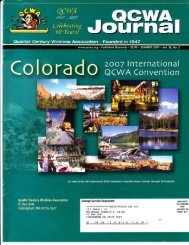
![11{J hI EfifSIt]E I]E - Quarter Century Wireless Association](https://img.yumpu.com/11816560/1/190x245/11j-hi-efifsite-ie-quarter-century-wireless-association.jpg?quality=85)
